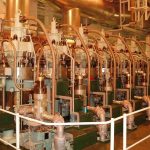The gas turbine engine, essentially a jet engine coupled to a turbine that is geared to a propeller shaft, appeared to have found a niche in commercial ship propulsion about 1970. However, the fuel price increase of the 1970s, which gave diesel its dominance over steam, gave it dominance over gas as well, and the niche for the latter suddenly disappeared. On the other hand, the gas turbine remains the principal propulsion engine among naval combat vessels because of the high power that can be produced from very low weights and volumes of machinery.
Steam propulsion survives in certain naval vessels—particularly submarines, where the heat source is a nuclear reactor. Extreme cruising range and independence from an air supply are advantages of using nuclear energy as the heat source in naval propulsion, but these advantages are of little merit in commercial shipping. A few prototype cargo ships with nuclear propulsion were built in the 1960s, but they did not lead to commercial application.
Electric drive and integrated machinery plants
Power is usually transmitted from propulsion engine to propeller by means of mechanical shafting. If the engine is a steam or gas turbine, or a medium-speed diesel engine, a speed reducer will be essential in order to match the most efficient engine speed to the most efficient propeller speed. The usual means for accomplishing this is mechanical gearing, but electrical transmission, with a propulsion motor running at a fraction of the speed of a propulsion generator, is an alternative.
Direct-current transmission is occasionally used because it allows propeller speed and engine speed to be completely independent. Alternating-current transmission with synchronous propulsion motors also is used, usually in high-powered propulsion plants because it avoids the commutation problems that handicap high-power direct-current machinery. Exact electrical synchronization of motor speed with generator speed is required, but the mechanical speeds need not be the same. The speed ratio between motor and generator is established by the number of poles in each machine, just as the respective number of teeth establishes a ratio between mating gears.
Electrical transmission was rarely applied to ships built between 1935 and 1970, but it enjoyed a revival of popularity after that. The impetus was the development of thyristor-based frequency converters for alternating-current power, along with the continuing recognition that electrical transmission offers a flexibility that is difficult to match with mechanical transmission. As examples of the latter point, power from a propulsion generator can be used for cargo handling, and a single generator can drive motors on several shafts. The frequency converters are a means of varying synchronous motor speed while frequency at the power source remains constant.
The typical electric-drive ship built in the late 20th century is a passenger cruise liner with twin propellers driven by synchronous alternating-current motors and powered by an array of medium-speed diesel engines driving synchronous generators. The engine-generators run at a constant 450 revolutions per minute, feeding 60-hertz current to a single bus. All power needs for the ship come from this bus, giving rise to the term integrated machinery plant. Power for the propulsion motors passes through thyristor-based frequency changers; by changing propulsion frequency, these devices regulate propeller speed while all other power users continue to receive 60 hertz from the main system.



Comments are closed